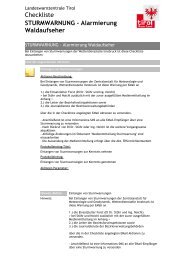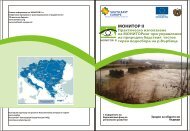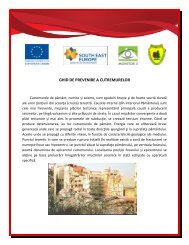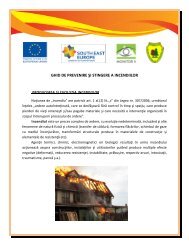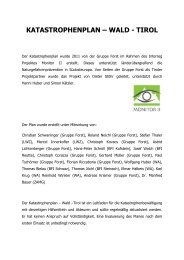risk management - monitor ii
risk management - monitor ii
risk management - monitor ii
You also want an ePaper? Increase the reach of your titles
YUMPU automatically turns print PDFs into web optimized ePapers that Google loves.
36 Monitor II Practical example<br />
Monitor II Practical example 37<br />
A synoptical example: flood at river Morava<br />
Basic geographical data<br />
The Morava river is a left-sided tributary of<br />
Danube river and is the border river between<br />
Austrian and Slovak Republic over a length<br />
of about 70 km. The catchment area exceeds<br />
25.000 km². Flooding at the Morava river<br />
typically occurs between March and May as<br />
a result of the snow melt in the mountainous<br />
part of the catchment area in Czech Republic.<br />
However, flood events with shorter duration<br />
also occur during summer and winter periods.<br />
An extensive system of flood protection<br />
dykes was constructed almost along the whole<br />
Slovak-Austrian river reach.<br />
Morava flood event 2006<br />
The extreme discharge situation in spring 2006<br />
was mainly caused by above-average snow<br />
packs being stored in the catchment area<br />
(150-200mm water equivalent). The water level<br />
of Morava river raised abruptly from March<br />
27th .and the water level reached a maximum<br />
from April 2nd to 4th with an occurrence<br />
probability of hundred years.<br />
On April 3rd, the flood protection dyke<br />
close to Jedenspeigen was over-topped and<br />
subsequently erased up to a length of 100 meters<br />
within a few hours. The fire brigades had to<br />
evacuate 400 inhabitants in Dürnkrut. Another<br />
dyke failure occurred few kilometers downstream,<br />
close to Mannersdorf on April 4th.<br />
All in all, about 890 individuals had to leave<br />
their homes and about 600 households<br />
were affected by the flood disaster. Private<br />
households and the Austrian railway track to<br />
Czech Republic heavily damaged between<br />
Angern and Dürnkrut, incurred the bigger part<br />
of the losses.<br />
The experiences of the flood event 2006<br />
showed major shortcomings with previously<br />
existing contingency plans, especially the lack<br />
of sufficient knowledge<br />
• on potential hazards deriving from<br />
dyke failure,<br />
• on the temporal aspects of the hazard<br />
scenarios and<br />
• on the details of feasible relief measures.<br />
As a reaction Lower Austria developed<br />
comprehensive and homogenous basis<br />
for flood emergency measures for the<br />
municipalities (co-financed by ERDF within<br />
project MONITOR), focussing on:<br />
• Definition of different hazard scenarios,<br />
including residual <strong>risk</strong> scenarios.<br />
• Identification of potentially affected areas,<br />
based on numeric modelling of dyke break<br />
and overtopping scenarios.<br />
• Classification of the potentially endangered<br />
buildings based on their use and degree<br />
of exposure; designing of evacuation zones.<br />
Collection of all relevant spatial data within<br />
the evacuation zones.<br />
• Actual situation classification of the dyke<br />
(geotechnical, design-elevation, logistic).<br />
• Development of possible defense measures<br />
at the flood protection system and of<br />
emergency measures in residential areas.<br />
1 Hazard<br />
assessment<br />
Evaluation of the<br />
hazard documentation<br />
and of geotechnical<br />
survey of the dykes<br />
Identification and<br />
definition of hazard<br />
scenarios.<br />
Definition of model<br />
parameters for dyke<br />
breaks (width of<br />
breach, temporal<br />
development).<br />
Modelling of 6 dyke<br />
break scenarios<br />
(HQ30 and HQ100)<br />
and 1 overload event<br />
(HQ300).<br />
Identification of<br />
critical scenarios.<br />
Summary as<br />
hazard maps.<br />
2 Risk assessment 3 Contingency<br />
Planning<br />
Comprehensive<br />
overview and classification<br />
of damage<br />
potential: persons,<br />
cultural and economic<br />
values.<br />
Definition of<br />
vulnerability (based on<br />
mobility of people,<br />
handling time, logistic<br />
framework conditions,<br />
situation on supply<br />
and disposal).<br />
Assessment of indirect<br />
damage potential<br />
by environmentally<br />
endangering<br />
substances.<br />
Information, communication<br />
Summary of hazard<br />
assessment, determination<br />
of<br />
warning and alert values<br />
for parameters, display<br />
the chain of information,<br />
register of contact data.<br />
Tasks and responsibilities<br />
of the authorities on<br />
regional, district and comunal<br />
level, of operators<br />
of protection systems<br />
and of the relief units<br />
Catalogue of<br />
measures: List of all<br />
emergency <strong>management</strong><br />
measures,<br />
temporally ordened into<br />
phases WARNING-ALERT-<br />
DISASTER-<br />
“ALL-CLEAR“.<br />
Description of<br />
measures, which are<br />
listed in the catalogue.<br />
Supporting plans:<br />
survey map, plan of measures,<br />
evacuation plans,<br />
data sheets<br />
and tables<br />
4 Implementation<br />
Contingency plan<br />
comes into force.<br />
Introduction of<br />
contingency plan to<br />
emergency forces<br />
(fire brigades) and<br />
training courses.<br />
Training with technical<br />
experts of authorities.<br />
Joint disaster control<br />
exercise.<br />
Periodic activities<br />
for the update and<br />
maintenance of data.<br />
Figure 38: Workflow of hazard / <strong>risk</strong> mapping and in contingency planning in case of Morava river (A.<br />
SCHWINGSHANDEL)<br />
Best practice work-flow for flood<br />
related contingency planning<br />
The work-flow used for the comprehensive<br />
hazard assessment – including definition of<br />
critical scenarios, and the subsequent <strong>risk</strong><br />
assessment and contingency plan development<br />
can be regarded as a best practice example<br />
for flooding<br />
According to feasibility of measures and to the<br />
computed water depths in the flooded areas,<br />
different kinds of barriers for flood defense in<br />
residential areas were designed. Most crucial<br />
criteria for the application of measures is the<br />
fact that the fire brigades and other emergency<br />
<strong>management</strong> forces have to be able to build<br />
up these barriers within a short period. Stability<br />
and the safety of the construction in conjunction<br />
with the dimensions of the barriers were<br />
relevant planning criteria. The same is essential<br />
for defense measures at the flood protection<br />
dykes. Limited access to the dykes because<br />
of lack of drivable roads makes it difficult to<br />
defend them over the whole length<br />
The flood contingency plan was developed in<br />
close cooperation with the municipalities, the<br />
local and district fire brigades, the authorized<br />
person for civil protection of the district, the<br />
Austrian waterway company and the regional<br />
government of Lower Austria.



